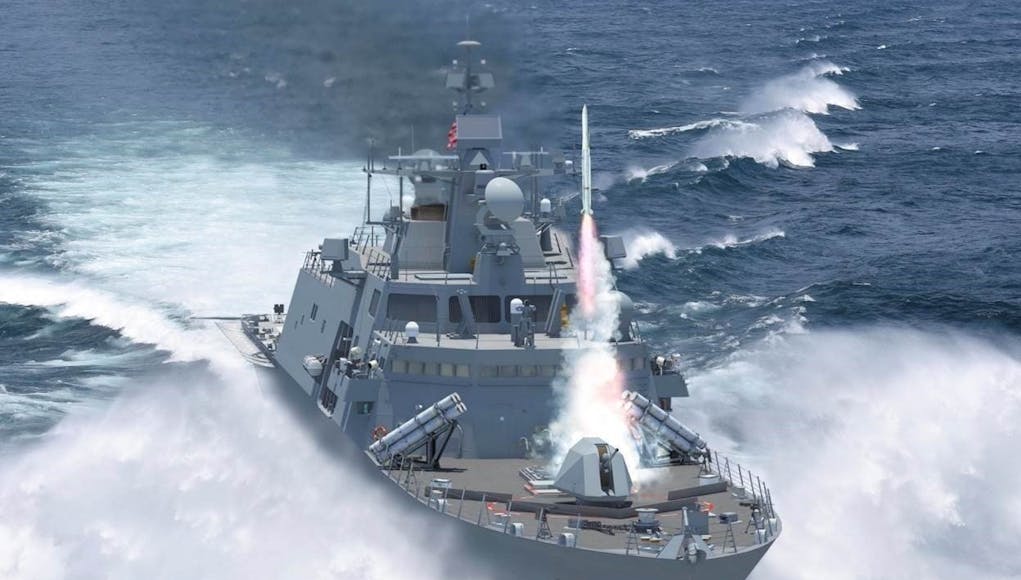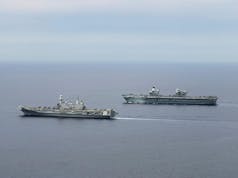The competition to build the US Navy’s next class of frigates has moved forward with five designs receiving $15 million contracts to mature their development.
The designs are each bidding for a contract to produce twenty next-generation guided missile frigates under the FFG(X) program. The program will follow on from the current LCS production lines and the new vessels are being designed to address some of the criticisms of the LCS vessels, such as their limited offensive firepower and limited integration with naval battle groups.
Under this next stage of the program, the conceptual designs will be developed and analysed for sixteen months ahead of a final proposal to be submitted for consideration in 2019. The final contract will then be awarded in 2020.
In a statement issued on Friday the Naval Sea Systems Command said that “these conceptual designs will reduce FFG(X) risk by enabling industry to mature designs to meet the approved FFG(X) capability requirements.”
“The contracts based on these requirements will facilitate maturing multiple designs during the 16 months of the conceptual design phase, and will allow the Navy to better understand the cost and capability drivers across the various design options. Furthermore, this will inform the final specifications for a full and open competition with a single source award in FY20 for Detail Design and Construction (DD&C) of the FFG(X).”
Each design is based on an existing class already in service or production for the US Navy or a foreign partner. Foreign designs required a partnership with a US based shipyard, and contractors were only allowed to make one bid as a prime contractor, but can support other bids as a subcontractor. The anticipated cost per vessel is between $800 and $950 million.
The five designs progressing into the next stage are;
An enlarged and upgunned variant of the Independence class LCS designed by Austal USA and to be built in their Mobile, Alabama shipyard.
An enlarged version of the Freedom class LCS, similar to the 4, 000 ton variant being built for the Royal Saudi Navy, designed by Lockheed Martin and to be built by Fincantieri Marinette Marine at Marinette, Wisconsin.
A 6,700 ton variant of the Italian FREMM frigate being offered by Fincantieri Marinette Marine to be built in their Marinette, Wisconsin Shipyard.
A variant of Navantia’s F100 design that is already in service with the Spanish, Norwegian and Australian navies, to be built by Bath Iron Works in Maine.
A frigate variant of the US Coast Guard’s Legend class national security cutter designed by Huntington Ingalls Industries to be built at Ingalls Shipyard in Mississippi.














No room for the type 26 frigate, however the Spanish F100 and Italian FREMM plus 3 US designs made the cut.
Not sure if BAE made a bid with the T26, but it’s seems a big loss either way with a minimum of 20 frigates required by the USN.
IIRC, I think the FFG(X) programme selection process requires a design drawn (albeit with modifications) from an existing hull that’s already in service, though I may be wrong
Required the ships offered to have reached at least near completion. The T26 was rejected because it took to long to lay one down. The USN’s logic being it doesn’t want to pay for the development of someone else’s toys.
Ah okay. Fallon’s endless dithering strikes again
Type 26 is probably a bit higher end then what the USN was looking at. I think it was something around max 800million USD. while the type 26 is already at like 1.3 billion USD.
Type 26 should sweep the Aussie and CAD frigate programs however.
950 million USD. As of January with contingency funds for modification added as needed.
Fingers crossed you’re right. Unlike the US, the Australians and Canadians are looking for higher end platforms.
Just did a bit of research into the Aussie future frigate project, the budget for 9x frigates is apparently AUS$35bn, while the the eight T26s are budgeted at £8bn, or AUS$13.8.
The T26 design will obviously need some adjustments (primarily AEGIS, but also more VLS unless the Aussies go for Sea Ceptor as well), but I can’t see how that could result in a budget 2.5x greater than the RN has given to essentially the same project?
Kirk and Callum
I’d speculate the design selected by the USN will be highly capable, most likely with max VLS, Aegis and CEC. If the programme extends past 20 ships unit costs will drop significantly.
I can’t see the Aust Govt wanting to go down the path of having to heavily modify a RN design to fit in US systems (additional VLS, AEGIS, CEC, GTs) especially when industry in Aust is already geared up to produce the F105 design. Just my view and I may be wrong but why spend a fortune modifying a design when we already have one which is extremely capable?
Kirk and Callum
I’d speculate the USN requirement is high end and the chosen design will feature max VLS, Aegis, CEC etc.
With the Hobarts, the RAN already has a high end design and while this is just my view, I can’t envisage the Aust Govt wanting to modify a RN design to incorporate US systems when industry is already geared to produce a high end design. Also, the issue of commonalties across the fleet should not be underestimated.
Australian defence project budgets typically incorporate the full though life costs of a project. This can include not just the cost of the ship/plane/vehicle but training including simulators etc.. weapons, spares, and base infrastructure (hangars, wharves, maintenance facilities) and frequently operating costs for a decade or two.
Government procurement and accounting policies now insist on full through life costing for major projects. ADF projects are now far better managed as a result and their introduction through IOC, FOC and into service ensure that capabilities are fully funded and the services will have what they need to operate the new kit. No budget surprises or shortfalls a few years down the track.
Unfortunately this frequently confuses both the press and the public. For example after the recent Growler engine fire at Nellis the Australian media were talking about the loss of a $300 million dollar airframe.
They had simply divided the ADF’s published full life cost for the Growler program by the number of aircraft to come up with a fanciful figure more than three times the fly away cost of a single aircraft.
The same applies to the RAN’s frigate program. Don’t be fooled by dividing the total project cost by the number of hulls.
I dont think T26 is actually £1bn per ship – the way the UK costs these vessels is crazy and not really a good sales pitch.
The cost of building, getting weapons and 10 years worth of maintenance and running comes to £1bn. the ship itself is probably $700-800m.
Including development costs (which are obviously divided between however many ships are in the programme) the T26 is £1bn per ship, amusing only about £50mn short of a T45. Its less about how we cost ships and more about how many delays we’ve had in recent projects, which has driven costs up, resulting in cuts to ship numbers. Suddenly those development costs aren’t spread across 12 or 13 ships, they’re spread across 6 or 8.
Regardless of that though, weapons and 10 years of maintenance aren’t included in the purchase cost. Sadly, those all have their own budgets
Unles the F100 derivative is selected, in which case anticipate Aus to go shopping for those instead. I’m sure the Aussies would jump at the chance to have a more homogenous surface fleet with cost savings through commonality of spares, training etc.
No T26 or T31. Seems the USN doubts the veracity of the RNs programmes too
They require it to be a tried and tested hull, the Type 26 hasn’t been put to the test yet so wouldn’t be considered. Plus, it’s probably too expensive and powerful for the designated role
I suggest the FFG(X) will better equipped with weapons and sensors than a RN T26, so the latter more powerful I think not.
The Type 31 is a concept at the moment, the USN is after an existing off the shelf design. As for the Type 26, its a high-end ASW fleet escort. Mass production and the weaker pound would probably bring the cost in at just about the top end of the budget, but there are existing designs out there that better meet the USN’s need for a patrol frigate.
My bet would be on the F-100 derivative, its already a successful frigate (unlike the LCS derivatives), and unlike the FREMM it already uses a majority of US systems (AEGIS, Mk41, etc), which reduces integration and supply costs. The original version was only about $600mn, so theres plenty of leeway for any modifications the USN has in mind. Its essentially a mini Arleigh Burke
My bet would either be F100 or the Huntington-Ingalls design.
Due to the F100 derivatives service in both the Spanish and Aussie Navies. In addition to use of American equipment the F100 was designed for Spain in a partnership with BIW so the yard is familiar with it.
While HII’s Patrol Frigate is essentially the war conversion that was built into the design requirement of the Coast Guards NSC still in production. Work force is already trained. The yard has already ironed out the build issues and can take on more orders.
True. It still confuses me so much that the USCG felt the need for their cutter to be designed to military standards and have missile defences. I mean, the budget for these things per unit was bigger than both the LCS and T31 programmes. In hindsight though, Huntington could definitely produce a decent warship off of that hull.
The F100 is still a better design in my opinion. It has a 5″ gun, AEGIS and a decent sized Mk41 farm, whereas the patrol frigate is only intended to have a 76mm, CEAFAR, and just 12 Mk56 tubes for ESSM.
USCG is taken under Naval control during war. So the larger vessels have a requirement for fitted for but not with.
The coast guard vessels do become part of the navy in time of war so I guess they represent a naval reserve in addition to their prescribed role. Indeed I believe in the early days on the west coast they were the navy and thus the tradition is somewhat different to that we are used to with the Coast Guard moniker.
FFG(X) has a high end specification, AEGIS, phased array sonar, CEC, multiple VLS launchers and so on.
If the reason that T26 was not considered mature enough, even though it is in production, then the UK MOD is to blame for sitting on their hands for six years while the T26 design was fiddled with.
A missed opportunity considering back into 2010, that’s 8 years ago, that the USA was seen as a potential user of T26.
Seems BAE were interested
https://www.defensenews.com/digital-show-dailies/dsei/2017/09/14/bae-is-in-the-race-for-the-the-us-ffgx-with-its-type-26-frigate/
Seems that overkill and untested are the terms that most thwarted its inclusion.
Agree with the untested statement, but surely when the UK MOD tested the viability of the T26 frigate they must have thought not everyone is prepared to pay £1bn for a high end frigate.
A cost effective modular design should be affordable and able to.meet the needs of the potential customer given cost and specification parameters.
Seems we have yet again created a new expensive bespoke design which only meets the needs of the RN and little export potential.
I am surprised type 26 and type 31 were not progressed through to next stage. It would have made a lot of sense to have a NATO standard frigate hull.
I guess that will probably go to FREMM as the most advanced and capable design, although the cost of FREMM probably excludes the design from the FFGX programme. I had read that 20 hulls was a minimum and in reality upwards of 36 hills are needed.
Whatever the reasons for the exclusion of the T26 this is missed opportunity for the UK.
It also sets a precedent in export markets, whatever platform is chosen this will give it a advantage when selling around the globe.
With the Australians having to decide between T26, F100 and FREMM they must be interested in the US decision and it’s implications. Also makes sense for the Canadians to review it’s requirements as well.
IMHO the renewed interest by the US in a new class of frigate is the final nail in the coffin for the Type 26 bid for the Australian frigate program.
The T26 was already the highest risk option being a long way off having a hull in the water plus essentially requiring a completely different sensor, combat system and weapons fitout to the RN design – essentially not much more than a donor hull.
Couple this with lingering doubts over UK propulsion engineering for tropical waters (T45, HMAS Choules Bay Class) and BAE’s track record of exorbitant costs.
By contrast the RAN’s other two short-listed contenders the Spanish Navantia and Italian Fincantieri are both already at sea (and in Navantia’s case a variant already in RAN service) plus both are on the USN’s shortlist.
With the US as Australia’s major defence ally and the only naval power able to challenge China in the Pacific, the synergies and benefits of a (near) common platform with the USN are almost irresistible.
Nostalgia for the Commonwealth and the UK’s belated (post Brexit) rediscovered interest in the Pacific aside, it makes more sense for the RAN in any case to adopt a design in common with a 20+ class of ships than a class of just 8.
The Drive ran with this story a few days ago with a little more info:
http://www.thedrive.com/the-war-zone/18582/one-of-these-five-ships-will-become-the-u-s-navys-next-frigate
I agree, its an excellent article.
Odd that the USA were, at one point, considering the German 125. Given what a POS that is it does appear there is a rush on to get frigates.
Also – are the yanks mad putting all their destroyer plans into the A-B destroyers? Read that the hull design will be 80 years old by the end of service life and there is very little room for future expansion.
‘Special relationship’ With Italy ? Spain ?
Given the any comments on Type 26, it should be pointed out that BAE never submitted the design for the Conceptual Design competition due to a ‘parent design’ constraint. A successful ship had to be based on a currently operational ship. Type 26 was never in the running.
The overall FFG(X) Design & Construction competition – which is in two years time – is mutually exclusive from this Conceptual Design phase and the winner may not be one of the 5 ships mentioned in this article. This is clearly stated in US government documentation. Type 26 may still have a chance of being the FFG(X) frigate. There’s a long way to go yet.
Further to my previous comment, the ‘parent design’ constraint only applies to the Conceptual Design competition and not the overall FFG(X) detailed design and construction competition in 2020. Essentially any ship designer not part of this CD phase will have to fund themselves for the next two years.
All of the speculation in the comments is fine but no one has mentioned what will really drive the US Navy in its decision. The US Navy wants a “mature design” at a relatively low predictable price. The only candidate that fits that bill is the Freedom class LCS, designed by Lockheed Martin, variant being built for Saudi Arabia by the Italian Firm Fincantieri in Wisconsin. The design is mature and already incorporates US GFE. Most importantly it carries 16 vertical launch cells which can easily be converted into 32 VLCs.
The wild card is the Huntington Ingalls design which is unknown but presumed to be based on its US Coast Guard National Security Cutter. Don’t underestimate HIL.